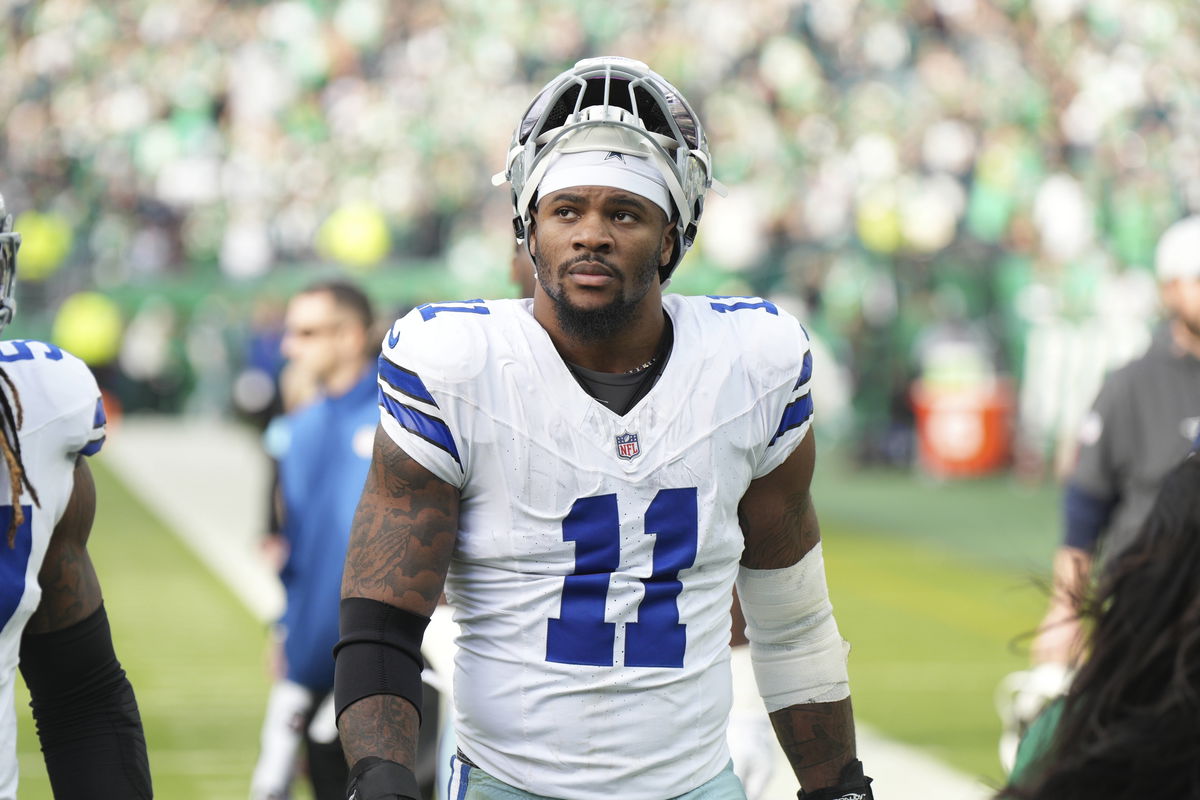
Imago
PHILADELPHIA, PA – DECEMBER 29: Dallas Cowboys linebacker Micah Parsons 11 looks on during the game between the Philadelphia Eagles and the Dallas Cowboys on December 29, 2024 at Lincoln Financial Field in Philadelphia, PA.Photo by Andy Lewis/Icon Sportswire NFL, American Football Herren, USA DEC 29 Cowboys at Eagles EDITORIAL USE ONLY Icon241229044

Imago
PHILADELPHIA, PA – DECEMBER 29: Dallas Cowboys linebacker Micah Parsons 11 looks on during the game between the Philadelphia Eagles and the Dallas Cowboys on December 29, 2024 at Lincoln Financial Field in Philadelphia, PA.Photo by Andy Lewis/Icon Sportswire NFL, American Football Herren, USA DEC 29 Cowboys at Eagles EDITORIAL USE ONLY Icon241229044
In the NFL, the thinnest of margins often separates a win from a loss. A fingertip deflection, a half-yard calculation, a referee’s angle. Now, for Micah Parsons, that razor-thin distinction isn’t about football. It’s about job titles. Linebacker or defensive end? The answer would swing millions of dollars and set the stage for one of the more complicated financial battles of the Cowboys’ future.
Watch What’s Trending Now!
Parsons’ pending grievance over his 2025 fifth-year option salary feels less like a standard business dispute and more like a case study in how the modern NFL struggles to categorize its own stars. The difference is dizzying: defensive end means $21.324 million; linebacker means just over $24 million. That $2.676 million gap is where frustration, perception, and contract fine print collide.
But here’s the twist. While the headlines scream ‘Cowboys vs. Micah Parsons,’ the real tug-of-war may not be between player and team at all. Parsons is asking a simple but costly question. Does his hybrid role make him the exception, or is he just another case of the NFL trying to fit a square peg into a round hole? Let’s try to break it all down…
ADVERTISEMENT
The $2.6 million question
As Pro Football Talk reported, the Cowboys designated Parsons as a defensive end for his fifth-year option, setting the number at $21.324 million. Parsons disagrees, insisting he’s a linebacker, which would raise his figure to $24 million.
The Collective Bargaining Agreement (CBA) seems to offer clarity. A player’s option is based on the position where he played the most snaps in his third season. But Parsons is hardly a standard case. As per PFF, in 2023, Parsons took the most snaps on the defensive line (87.2%), but he also had 12.7% snaps as a linebacker and 0.1% snaps as a defensive back. As Fort Worth Star-Telegram’s Nick Harris explained, “It’s important to note that the Cowboys are not the primary counterpart in this grievance, it’s the NFL. – The blurred lines between LB and DE make it tough to decipher, but it was the NFL that classified him as a DE.”
ADVERTISEMENT
It’s important to note that the Cowboys are not the primary counterpart in this grievance, it’s the NFL.
The CBA states that your fifth-year option is paid based on what position you play the most snaps at in your third year. The blurred lines between LB and DE make it tough to… https://t.co/JSUELeZon3
— Nick Harris (@NickHarrisFWST) August 27, 2025
That reframes the fight. It’s not just another Dallas contract squabble. It’s Parsons versus the system’s classification.
ADVERTISEMENT
Why this matters beyond Micah Parsons
The debate highlights a bigger issue within the league. Do positional definitions keep pace with how defence actually functions? Mike Florio put it bluntly: “The grievance ultimately will be driven by, based on the CBA, a one-play-at-a-time calculation of whether he was a linebacker or a defensive end. Throw in the reality that linebackers often line up as edge rushers, and the process becomes more complicated.” Imagine lawyers and league officials breaking down film like defensive coordinators, tallying whether each snap counts for one box or another. That’s how this will be resolved in the end.
Top Stories
Cam Newton Makes NFL Return Conditions Clear to 32 Teams as Panthers Legend Confirms Retirement Stance

Tom Brady Makes Career Announcement for Vegas as Pete Carroll Addresses Losing Raiders Locker Room

“RIP”: Prayers Pour In as Tom Brady’s Raiders Struck by Tragedy

“NFL Was Crying”: Maxx Crosby Says League Forced Him to Remove Shoes Honoring His Daughter

“Rest in Peace”: Prayers Pour In From Dan Marino as Dolphins Legend Mourns Tragedy in South Florida Football

Other stars have fought this battle before. Jimmy Graham tried after the 2013 season ended and the Saints franchise tagged him as a tight end, even though he lined up as a receiver 67% of the time. Graham argued that he was effectively a wide receiver and deserved the tag value to match. He lost, but his case exposed how blurred roles create pay-scale friction. Micah Parsons may not be the latest example, but he might be the most influential one. His hybrid dominance is exactly what defences want, but the league’s salary structure or play classification guidelines have yet to catch up.
ADVERTISEMENT
The Cowboys’ tightrope and a league-wide problem
For Dallas, this fight is only one piece of a massive financial puzzle. Parsons will eventually command a deal that could make him the highest-paid non-quarterback in the league, eclipsing the current king on the throne. T.J. Watt of the Pittsburgh Steelers currently stands at the top with his $41 million average yearly payout. That makes this grievance feel like a prologue. Whether Parsons wins or loses, the Cowboys know their future hinges on paying him as a cornerstone talent. But every dollar counts, especially when layered with other megadeal negotiations and Jerry Jones’ trademark last-minute moves.

Imago
PHILADELPHIA, PA – DECEMBER 29: Dallas Cowboys defensive lineman Micah Parsons 11 looks on before the game between the Dallas Cowboys and Philadelphia Eagles on December 29, 2024 at Lincoln Financial Field in Philadelphia, PA. Photo by Kyle Ross/Icon Sportswire NFL, American Football Herren, USA DEC 29 Cowboys at Eagles EDITORIAL USE ONLY Icon24122965
It’s more than cap math, though. It’s about friction. Even though this case isn’t strictly Cowboys vs. Parsons, every appearance of a dispute adds tension. For the Cowboys Nation, it looks less like a technicality and more like a star player being undervalued. But ultimately, Parsons’ grievance underscores a structural issue for the NFL. Hybrid players aren’t going away; they’re multiplying. Case in point: Travis Hunter’s dual-threat caliber for the Jaguars. Edge rushers who double as off-ball linebackers, safeties who moonlight as slot corners, tight ends flexing into receivers. As schemes evolve, the league’s compensation rules risk leaving players underpaid for their true impact.
ADVERTISEMENT
What’s next for Parsons?
So, who’s really at fault here? The Cowboys simply followed the NFL’s classification, which narrowed Parsons to ‘defensive end’ by its snap-count criteria. The league’s bookkeeping, not Dallas’s preference, drove the number lower. That’s why this grievance isn’t just another Cowboys storyline. It’s a test case for how the NFL handles its most adaptable stars and whether its rules can evolve as quickly as the game itself.
ADVERTISEMENT
If Parsons wins, he secures a $2.6 million bump and momentum heading into his next contract. If he loses, nothing changes except the urgency for Dallas to secure a long-term deal before the existing contract standoff escalates further. For now, though, the fight over linebacker versus defensive end rages on. The game recognizes Parsons as far more than just one or the other. The question is whether the system can do the same. Either way, all sides know the ending: Parsons won’t be boxed in forever.
ADVERTISEMENT
ADVERTISEMENT
ADVERTISEMENT

